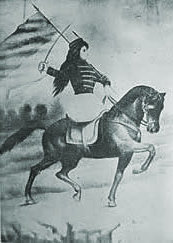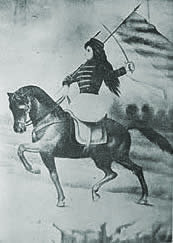
|
Women and Independence in Latin America An exploration of women's involvement in the Latin American Wars of Independence |

|

|
Women and Independence in Latin America An exploration of women's involvement in the Latin American Wars of Independence |

|
Click on the image below to see the full-size image
 María Parado |
Other names: Parado, Velido
Gender:Female
Ethnic origen: Indigenous
Events:
| 1761 | - | Ayacucho | - | Not applicable | - | Born in Ayacucho, Peru. |
| 1792 | - | Ayacucho | - | Unknown | - | She married Mariano Bellido. |
| 1822 | - | Ayacucho | - | Unknown | - | She was executed on 1 May 1822. |
| 1822 | - | Ayacucho | - | Unknown | - | On 26 March 1822 she warned her husband of royalist movements. She was imprisoned on 29 March 1822. |
Connections:
Women executed independence cause (Peru)Biography:
She was born in 1761 (some sources say 1777) in Ayacucho
She participated actively in the independence struggle. (Knaster, 500)
She married Mariano Bellido and had one son, Tomás Bellido y Parrado. Cúneo Vidal quotes a letter to her husband dated 20 March 1822, Guamanga (see below). The letter seems to have got into the wrong hands and condemned her. Cúneo Vidal gives her year of death as 1822, when she died for the patria. (Cúneo Vidal, 481-505)
She was shot near Ayacucho for refusing to give information to the royalists. (Neuhaus Rizo, 119)
A play was written about her in 1878. (Freire)
She was imprisoned on 29 March 1822, when the letter was intercepted. The following day her house was set alight and her daughters put onto the street. Neighbours were forbidden to give them shelter, and the nunneries closed their doors to them. María Parrado was sentenced to death. (Guardia, 47-48)
She was born in Huamanga (today Ayacucho) in 1777. She is said to have been very beautiful, but she refused to have her portrait taken due to the traditional reserve of indigenous Peruvians. She married Mariano Bellido, when she was 15, they had 7 children. They were comfortably off because all of them worked as messengers during the colonial period. Her fourth son, Tomás, enlisted in the independence army under General Arenales. Andrea Parrada then sent her daughters, Gregoria and Andrea, to ask his commander, Quirós to release him, offering 500 pesos instead. Tomás was a good soldier but Quirós could not resist the women's tears and released Tomás so he could return to his family. But when Tomás learned of this he went before Quirós pointing out that he had joined the cause of his own free will and from conviction and suggested Quirós should keep the 500 pesos for the cause, but he refused to return to his house until independence was secured. So Tomás Bellido stayed in the patriot army.
Royalist troops occupied Huamanga and was intent on wiping out Quirós's troops. Parrado de Bellido kept Quirós informed of their movements through her husband who was Receptor de Correos. The letter quoted below (which differs from that above) was written for her by Matías Madrid as she was illiterate and could barely sign her name. It was taken to Mariano Bellido by a trustworthy Indian, but he was intercepted by royalists and the letter was confiscated. Quirós nonetheless learned of the royalists´ plans and retired to Ica where he joined forces with Tristán's troops. At 8 pm on 29 March, Spanish soldiers arrived at the house of the "infeliz india" Parrado de Bellido. She was taken before the authorities who demanded the identity of the person who'd written the letter (there was an obvious discrepancy between her signature and the letter itself). She refused to give Madrid's name and was condemned to death. She accepted her punishment with such calm that made her enemies despair. On the day of her execution she was taken through to the plaza major, and on each street corner her sentence was read out to inspire terror, but she was unmoved. A Spanish priest told her that her stubbornness would not achieve anything but pain and misery to her children. She said goodbye to her children and "Viva al Perú libre e independiente". The crowd wept as the Spanish soldiers killed her with 5 shots. (García y García, 235-238)
Her name is spelt in several ways.
References:
Cúneo Vidal, Rómulo (1978) Precursoras y mártires de la independencia del Perú
Freire, Carolina (1878) María de Vellido
García y García, Elvira (1924) La mujer peruana a través de los siglos
Guardia, Sara Beatriz (1985) Mujeres peruanas: El otro lado de la historia
Knaster, Meri (1977) Women in Spanish America: An Annotated Bibliography from Pre-Conquest to Contemporary Times
Neuhaus Rizo Patrón, Carlos (1997) Las Mariscalas